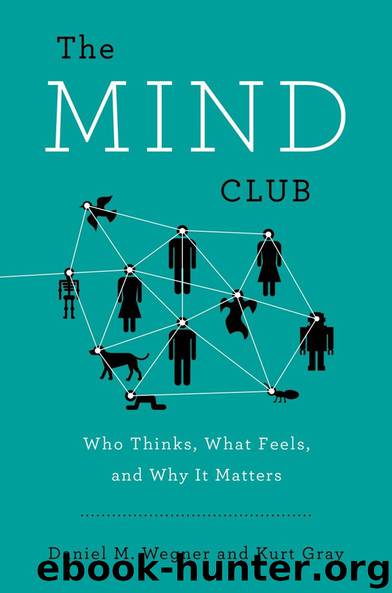The Mind Club: Who Thinks, What Feels, and Why It Matters by Daniel M. Wegner & Kurt Gray

Author:Daniel M. Wegner & Kurt Gray [Wegner, Daniel M.]
Language: eng
Format: epub, mobi
Publisher: Penguin Publishing Group
Published: 2016-03-21T23:00:00+00:00
Figure 35: Reptilian
An artist’s interpretation of a Reptilian leader of the New World Order, a legitimate conspiracy theory.
Why do conspiracy theories emerge so robustly to explain tragedies such as disease, war, and death? The answer—as you may have guessed from previous chapters—is dyadic completion. When there is a tragedy, people seldom throw up their hands, say, “C’est la vie,” and accept the inherent randomness of life. Instead they search for meaning, asking not only how something bad could have happened but also who is behind it. When people feel like suffering moral patients, their dyadic moral template compels them to find moral agents to hold responsible. We first saw this kind of “agentic dyadic completion” in chapter 2 on animals, where people put a pig on trial for the death of a child.
As an easy example, consider rush-hour driving. When a car cuts you off during your daily commute, you likely seldom think, “They must be in a hurry,” or even, “They’re a little distracted,” but instead, “That asshole knew I was there and cut me off just to spite me!!” The link between perceptions of harm and perceptions of evil intention is nicely illustrated by a pair of scenarios designed by philosopher Joshua Knobe.
Both scenarios feature a chairman of the board presented with a new, profitable project by a company vice president. In the first case, the VP says, “We are thinking of starting a new program. It will help us increase profits, but it will also help the environment.” The chairman of the board then answers, “I don’t care at all about helping the environment. I just want to make as much profit as I can. Let’s start the new program.” The question is whether the chairman intentionally helped the environment. Most people in this case answer no—if the CEO doesn’t care about helping the environment, then the help is unintentional. But now consider the second scenario with only one word changed.
The VP now says to the chairman of the board, “We are thinking of starting a new program. It will help us increase profits, but it will also harm the environment.” The chairman of the board then answers, “I don’t care at all about harming the environment. I just want to make as much profit as I can. Let’s start the new program.” Did the chairman intentionally harm the environment? Most people now answer yes—if the CEO doesn’t care about harming the environment, then the harm is intentional.19 This is a striking reversal. His words and deeds were exactly the same in both cases, and in both cases he was motivated only by profit. However, psychologically we perceive the good act to be merely incidental and the evil act to be intentional.
Harm compels us to find a mind to blame, but not all minds are equally blameworthy. You’ll notice that the environmental harm was pinned on a business leader and not a puppy, as dyadic completion can only occur with someone or something that possesses a lot of agency.
Download
The Mind Club: Who Thinks, What Feels, and Why It Matters by Daniel M. Wegner & Kurt Gray.mobi
This site does not store any files on its server. We only index and link to content provided by other sites. Please contact the content providers to delete copyright contents if any and email us, we'll remove relevant links or contents immediately.
The Art of Thinking Clearly by Rolf Dobelli(8841)
The 5 Love Languages: The Secret to Love That Lasts by Gary Chapman(8494)
Mindhunter: Inside the FBI's Elite Serial Crime Unit by John E. Douglas & Mark Olshaker(7833)
Becoming Supernatural by Dr. Joe Dispenza(7105)
Nudge - Improving Decisions about Health, Wealth, and Happiness by Thaler Sunstein(6633)
The Road Less Traveled by M. Scott Peck(6633)
Enlightenment Now: The Case for Reason, Science, Humanism, and Progress by Steven Pinker(6405)
Win Bigly by Scott Adams(6311)
Mastermind: How to Think Like Sherlock Holmes by Maria Konnikova(6234)
The Way of Zen by Alan W. Watts(5798)
Factfulness: Ten Reasons We're Wrong About the World – and Why Things Are Better Than You Think by Hans Rosling(4021)
The State of Affairs by Esther Perel(3926)
Gerald's Game by Stephen King(3918)
Man's Search for Meaning by Viktor Frankl(3631)
The Confidence Code by Katty Kay(3566)
Thinking in Bets by Annie Duke(3531)
The Worm at the Core by Sheldon Solomon(2917)
Enlightenment Now by Steven Pinker(2914)
Liar's Poker by Michael Lewis(2810)
